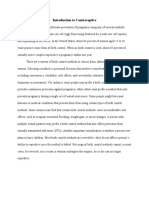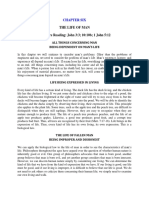Common Methods of Contraception Methods With No User Failure Method Effectiveness How It Works Advantages Disadvantages
Common Methods of Contraception Methods With No User Failure Method Effectiveness How It Works Advantages Disadvantages
Uploaded by
Michael BriscoeCopyright:
Available Formats
Common Methods of Contraception Methods With No User Failure Method Effectiveness How It Works Advantages Disadvantages
Common Methods of Contraception Methods With No User Failure Method Effectiveness How It Works Advantages Disadvantages
Uploaded by
Michael BriscoeOriginal Description:
Original Title
Copyright
Available Formats
Share this document
Did you find this document useful?
Is this content inappropriate?
Copyright:
Available Formats
Common Methods of Contraception Methods With No User Failure Method Effectiveness How It Works Advantages Disadvantages
Common Methods of Contraception Methods With No User Failure Method Effectiveness How It Works Advantages Disadvantages
Uploaded by
Michael BriscoeCopyright:
Available Formats
COMMON METHODS OF CONTRACEPTION METHODS WITH NO USER FAILURE METHOD
CONTRACEPTIVE INJECTION
EFFECTIVENESS
OVER 99% EFFECTIVE
HOW IT WORKS
Releases progesterone which prevents ovulation, thickens the cervical mucosa and thins the lining of the uterus to prevent implantation Small flexible rod inserted under the skin of the upper arm. Releases progesterone which produces same effects as injection Inserted using a local anesthetic
ADVANTAGES
Lasts 8-12 weeks depending on type of injection Can be used when breast feeding Effective for three years, but can be removed sooner Dont hve to think about contraception as long as implant is in place Fertility returns once removed Effective for 5 years but can be taken out sooner Periods usually lighter, shorter, and sometimes less painful Fertility returns once removed
DISADVANTAGES
Periods may stop, be irregular, or longer Periods and fertility may take some time to return Potential weight gain Periods may stop, be irregular, or longer Acne may occur or worsen Requires a procedure which may be offputting
IMPLANT
OVER 99% EFFECTIVE
INTRAUTERINE SYSTEM (IUS) OVER 99% EFFECTIVE A small device inserted into the uterus which slowly releases the hormone progesterone
INTRAUTERINE DEVICE
Over 99% effective
Small plastic and copper device placed into uterus. Stops sperm reaching the egg and may also prevent implantation
Effective immediately and for 5-10 years depending on type Fertility returns once removed Not affected by medications
FEMALE STERILIZATION (TUBAL OCCLUSION)
FAILURE RATE IS 1 IN 200. THIS IS A PERMANENT METHOD
Fallopian tubes are cut, sealed, or blocked. Stops meeting of the sperm and egg
Does not interrupt sex Cannot easily be reversed Periods unaffected No need for contraception
Irregular bleeding common in first 6 months Periods ,ay stop altogether Small chance of infection 20 days after insertion Ovarian cysts Insertion can be uncomfortable May not be suitable for women at risk of STI Periods may be heavier, longer and painful Insertion can be uncomfortable Small risk of infection upon insertion Operation risk Small increased risk of ectopic pregnancy if sterilization fails General or local anesthetic
MALE STERILIZATION
FAILURE RATE OF 1 IN 2,000 PERMANENT METHOD
Vas deferens cut, sealed, and tied
Does not interrupt sex Cannot be reversed No need for contraception Performed under a local anesthetic
Contraception must be used until semen test shows no sperm are remaining. Can take up to 8 weeks Some men experience ongoing testicle pain
METHODS WITH USER FAILURE METHOD EFFECTIVENESS
CONTRACEPTIVE VAGINAL RING 99% EFFECTIVE IS USED CORRECTLY (1 woman in 100 / year)
HOW IT WORKS
Small flexible plastic ring inserted into vagina releases estrogen and progesterone. Stops ovulation, thickens cervical mucosa and thins lining of the uterus to prevent implantation
ADVANTAGES
Not affected by illness such as sickness and diarrhea Can make bleeds regular, lighter, and less painful May reduce risk of ovarian and uterine cancers
DISADVANTAGES
Not suitable for overweight women or smokers over 35 Low risk of serious sideeffects such as blood los, breast and cervical cancer Temporary side-effects such as vaginal discharge, headaches, nausea, breast tenderness and mood changes Some medicines can make it less effective Not suitable for overweight women, or smokers over the age of 35 Low risk of side-effects Temporary side-effects e.g. headaches Possible skin reaction Not suitable for overweight and smokers Low risk of serious sideeffects Temporary side effects such as headache Missing pills make it less effective Periods may stop, be irregular, light or more frequent Temporary side-effects such as acne, breast tenderness, weight change Risk of ovarian cysts Needs to be taken at same time each day Some medicines reduce effectiveness Putting it on can interrupt sex May slip off or split if not used correctly, or is wrong size or shape Man needs to withdraw immediately after ejaculation and before the penis softens Oil based products damage latex condoms Putting it on can interrupt sex Need to make sure the penis enters the condom and not the space between the condom and vagina May get pushed into vagina Not as widely available
CONTRACEPTIVE PATCH OVER 99% EFFECTIVE LESS THAN 1 WOMAN IN 100/ YEAR Small patch placed onto skin releases estrogen and progesterone. Prevents ovulation, thickens cervical mucus and thins lining of the uterus to prevent implantation Contains estrogen and progesterone. Not affected by sickness Periods usually more regular, lighter and less painful May reduce risk of cancers Periods usually more regular, lighter and less painful Reduces risk of cancers Suitable for healthy non-smokers up to menopause Fertility returns once stopped Can be used bt women who cannot use estrogen Can be used by women who smoke and are over 35 Can be used when breast feeding
COMBINED PILL
OVER 99% EFFECTIVE IF TAKEN CORRECTLY <1 WOMAN IN 100 / YEAR
PROGESTERONE-ONLY PILL
OVER 99% EFFECTIVE IF TAKEN CORRECTLY <1 WOMAN IN 100 / YEAR
Contains progesterone, in some cycles stops ovulation
MALE CONDOM
98% EFFECTIVE (although suggested 15% failure rate)
Made of latex or polyurethane. Placed over erect penis to prevent entry of sperm
Free from contraception and sexual health clinics and sold widely Protects from STIs No serious side-effects Spermicide s not needed
FEMALE CONDOM 95% EFFECTIVE IF USED ACCORDING TO INSTRUCTION 5 women in 100/ year Soft, thin polyurethane sheath loosely lines the vagina and covers the area just outside and stops entry of sperm Can be put in any time before sex Protects both partners from STIs Oil-based products can be used with female condoms Spermicide not needed
DIAPHRAGM/ CAP WITH SPERMICIDE
92-96% EFFECTIVE WHEN USED WITH SPERMICIDE 4-8 WOMEN PREGENANT PER YEAR
Flexible latex or silicone device, used with spermicide, put into vagina to cover cervix. Stops sperm entering the uterus
Can be put in anytime before sex Only have to use it when you have sex Can be used during menstruation
Putting it on can interrupt sex Some people sensitive to spermicide Can take time to learn how to use correctly Needs to be left in for 6 hours after sex Need to avoid having sex, or use a condom during fertile times Takes 3-6 menstrual cycles to learn effectively Must keep daily records
NATURAL FAMILY PLANNING
UP TO 99% EFFECTIVE
Fertile and infertile times of the menstrual cycle are identified by noting different fertility indicators This shows when you can have sex without risking pregnancy
No physical side-effects No chemicals or products needed Gives woman a greater awareness of her body Can be used to plan pregnancy
EMERGENCY CONTRACEPTION Designed for use after unprotected intercourse: IUD o Reliable o Kills sperm HORMONES (morning after pill) E.g. LEVONELLE synthetic version of the natural hormone progesterone o High dose of combined contraceptive given in two doses o 12 hours apart o Within 72 hours of unprotected sex o Makes endometrium less stable and delays ovulation o Side effects include: Nausea Menstrual disturbances Abdominal cramps Mood swings Breast tenderness
COMPONENTS OF THE SEXUAL HEALTH SCREEN 1. 2. GUM (genitourinary medicine) clinics and STI clinics hold drop-in sessions and scheduled appointments The clinic is open to the wide public, and even under 16s can attend without risking confidentiality if the circumstance is fit 3. Confidentiality of under 16s will be breached only if harm to any party is suspected. The attendee must first be informed of this 4. GPs are not told of patient visits without permission 5. Fake names are common place 6. TESTS MAY INCLUDE: a. Urine sampling b. Blood samples c. Vaginal and urethral swabs d. A genital examination 7. Results can be reveived on the same day as testing, depeidng on the type of test 8. Testing positive for an STI will necessitate the need to return to the clinic and discuss treatment options 9. Many STIs can be cured with antibiotics 10. Clinics also offer safe sex advice including the use of condoms OTHER SERVICES OFFERED INCLUDE: Specialist advice Screening for sexually transmitted infections Chlamydia screening Contraception Emergency contraception Pregnancy testing Free condoms Young mens drop-in Advice and referral to termination services Psychosexual clinics - GP/consultant or family planning doctor referral only
LEGALITY, CONFIDENTIALITY, AND CONSENT WITH REGARDS TO ADOLESCENTS ISSUES SURROUNDING PRESCRIPTION OF CONTRACEPTIVES TO TEENAGERS o Is it legal for doctors to prescribe to them? (Consent and Competence) o Will the doctor tell the parents? (Confidentiality) CONSENT o Age of Legal Capacity (Scotland) Act 1991 16 o Gilick Competency Contraception can only be given without parental consent IF child is deemed competent Parents rights were not absolute but exist only in the benefits of the child DOCTORS NOT LEGALLY OBLIGED TO TELL PARENTS IF FOLLOWING 5 CONDITIONS ARE MET: THE ADVICE GIVEN IS UNDERSTOOD THE GIRL CANNOT BE PERSUADED TO TELL HER PARENTS SHE IS LIKELY TO HAVE SEXUAL INTERCOURSE WITH OR WITHOUT CONTRACEPTION IF NOT GIVEN THE ADVICE SHE SEEKS, HER MENTAL HEALTH WILL SUFFER IT IS IN HER BEST INTERESTS FOR HER TO RECEIVE THE ADVICE
Factors influencing Teenage Use of Contraception Main determinants o Adequate sexual and contraceptive education o High preventive motivation o Self-confidence and communication skills o Easy access to acceptable services Contraceptives have been free since 1975 Sex Education Forum was set up by National Childrens Bureau in 1987 o Provides support and guidance to sex educators o Education to foster Self Esteem Self-Awareness Sense of moral responsibility Skills to resist unwanted sexual experience Teenage knowledge of contraceptives is usually poor Doctors play a large role in provision o Teenagers are unwilling to approach as they are worried of being found out by their parents. Legality, confidentiality, and consent with regards to adolescents. Issues surrounding prescription of contraceptives to teenagers o Is it legal for doctors to prescribe to them? (Consent and Competence) o Will the doctor tell the parents? (Confidentiality) Consent o Age of Legal Capacity (Scotland) Act 1991 16 o Gilick Competency Contraception can only be given without parental consent IF child is deemed compentent Parents rights were not absolute but exist only in the benefits of the child Doctors not legally obliged to tell parents if following 5 conditions are met The advice given is understood The girl cannot be persuaded to tell her parents She is likely to have sexual intercourse with or without contraception If not given the advice she seeks, her mental health will suffer It is in her best interests for her to receive the advice
You might also like
- 20 Steps To Reading PDFDocument62 pages20 Steps To Reading PDFтетяна дзьоба100% (2)
- FMS Screen Scoring SheetDocument1 pageFMS Screen Scoring SheetSara Leonardo LacerdaNo ratings yet
- Cat Folklore and MagicDocument9 pagesCat Folklore and MagicO.L.D.E.No ratings yet
- External Parts of FishDocument18 pagesExternal Parts of FishHazel Leah KhaeNo ratings yet
- FNCP - TB As A Health DeficitDocument6 pagesFNCP - TB As A Health DeficitIngrid Paula Nicolas100% (4)
- Gynea NotesDocument947 pagesGynea NotesCANWAT TONNYNo ratings yet
- ArtificialDocument5 pagesArtificialAreeya SushmitaNo ratings yet
- Birth ControlDocument42 pagesBirth ControlSelang PastNo ratings yet
- Artificial Family Methods 1Document4 pagesArtificial Family Methods 1nagaamera73No ratings yet
- Family Planning SpeechDocument2 pagesFamily Planning SpeechLietOts KinseNo ratings yet
- FAMILY PLanning FinalDocument23 pagesFAMILY PLanning FinalLebo Ramokolo100% (1)
- Contraceptive MethodsDocument30 pagesContraceptive MethodsLoice Buza100% (1)
- Family Planning ConciseDocument117 pagesFamily Planning Concisegracebally06No ratings yet
- Material To Read ContraceptionDocument12 pagesMaterial To Read Contraception8kx6rvg5p6No ratings yet
- Family PlanningDocument53 pagesFamily PlanningAngeloLorenzoSalvadorTamayoNo ratings yet
- Your Birth Control Choices: Method How To Use Pros ConsDocument2 pagesYour Birth Control Choices: Method How To Use Pros ConsKarina Puspita SariNo ratings yet
- Artificial Family Planning Methods Artificial Family Planning MethodsDocument33 pagesArtificial Family Planning Methods Artificial Family Planning MethodsJullienne Ysabelle AngNo ratings yet
- Responsible ParentingDocument50 pagesResponsible ParentingFaith MontefalcoNo ratings yet
- Chapter 20 LODocument61 pagesChapter 20 LOcalfornianursingacadNo ratings yet
- Introduction To ContraceptiveDocument12 pagesIntroduction To ContraceptiveLisa Nelson-FriginetteNo ratings yet
- Family PlanningDocument15 pagesFamily PlanningIdara AlphonsusNo ratings yet
- Reproductive-Life-Planning - 20230914 190853 0000Document27 pagesReproductive-Life-Planning - 20230914 190853 0000Bea GualbertoNo ratings yet
- Contraceptive Methods HandoutsDocument14 pagesContraceptive Methods Handoutsapi-253521358No ratings yet
- Different Methods of Contraceptive Measures Used For Family PlanningDocument5 pagesDifferent Methods of Contraceptive Measures Used For Family PlanningAllyzamhae AvesNo ratings yet
- Family Planning: Artificial MethodDocument22 pagesFamily Planning: Artificial MethodSkyllen FhayeNo ratings yet
- Family PlanningDocument44 pagesFamily PlanningNica RiogelonNo ratings yet
- Contraceptive Methods Adesh KumarDocument38 pagesContraceptive Methods Adesh KumarAlok kumar RajanNo ratings yet
- Lecture 1 Family PlanningDocument84 pagesLecture 1 Family PlanningAlfie Adam Ramillano100% (4)
- FAMILY PLANNING MCN 101Document31 pagesFAMILY PLANNING MCN 101kaycelyn jimenezNo ratings yet
- Hormonal Contraception Methods (Iter)Document12 pagesHormonal Contraception Methods (Iter)Lady JNo ratings yet
- Abstinence: DESCRIPTION: No Sex or Intimate Contact Until You'reDocument13 pagesAbstinence: DESCRIPTION: No Sex or Intimate Contact Until You'rerushie23No ratings yet
- Family PlanningDocument4 pagesFamily PlanningangelasotocornetaNo ratings yet
- Family PlanningDocument10 pagesFamily Planningdalvin20207967No ratings yet
- CONTRACEPTION LectureDocument49 pagesCONTRACEPTION LectureAnton OcampoNo ratings yet
- Family Planning (Dr. Saleem Adil)Document54 pagesFamily Planning (Dr. Saleem Adil)salimadilNo ratings yet
- ContraceptionDocument33 pagesContraceptionShams AtrashNo ratings yet
- 6.contraceptive and Family Planning Group One AssigmentDocument36 pages6.contraceptive and Family Planning Group One AssigmentBekeNo ratings yet
- Family PlanningDocument19 pagesFamily Planninglabu matahNo ratings yet
- Final Resech PaperDocument9 pagesFinal Resech Paperapi-459387406No ratings yet
- Family Planning Services and Infertility 2Document51 pagesFamily Planning Services and Infertility 2HSM IjebuNo ratings yet
- Notes On ContraceptionDocument2 pagesNotes On ContraceptionImad Q. KhaleelNo ratings yet
- Myths & Facts I Love MeDocument81 pagesMyths & Facts I Love Mejasjit12345No ratings yet
- The 5 Kinds of IUD Birth Control and Their Side EffectsDocument27 pagesThe 5 Kinds of IUD Birth Control and Their Side EffectsGladie Ann Dela RosaNo ratings yet
- Family Planning Community Health PresentationDocument19 pagesFamily Planning Community Health PresentationLeAnnaNo ratings yet
- ContraceptionDocument57 pagesContraceptionEmerson SantosNo ratings yet
- 3 Family PlanningDocument75 pages3 Family PlanningArjlyn BiagoNo ratings yet
- Famly Planing 1Document58 pagesFamly Planing 1Dwi Mas IstriNo ratings yet
- Week 7.1 FAMILY PLANNINGDocument30 pagesWeek 7.1 FAMILY PLANNINGkappaNo ratings yet
- Billings LIFE Ebook - Preventing PregnancyDocument18 pagesBillings LIFE Ebook - Preventing PregnancyAnonymous RxYPapGqNo ratings yet
- CONTRACEPTIONSDocument65 pagesCONTRACEPTIONSCharmaine FernandezNo ratings yet
- Methods of Contraception 1. Permanent ContraceptionDocument7 pagesMethods of Contraception 1. Permanent ContraceptionCaurrine MonsaludNo ratings yet
- Natural Family Planning MethodsDocument9 pagesNatural Family Planning MethodsJeff LibaoNo ratings yet
- BiologyDocument22 pagesBiologymahalsuraj389No ratings yet
- Methods of Family PlanningDocument46 pagesMethods of Family PlanningEyob MizanNo ratings yet
- QweasdDocument4 pagesQweasdJude FabellareNo ratings yet
- Different Methods of Family PlanningDocument8 pagesDifferent Methods of Family PlanningFamela LauzonNo ratings yet
- The Intrauterine Device (IUD) : What Is It? Is An IUD Right For You?Document2 pagesThe Intrauterine Device (IUD) : What Is It? Is An IUD Right For You?Hanako Laros RatuwangiNo ratings yet
- CONTRACEPTIONDocument8 pagesCONTRACEPTIONeileenNo ratings yet
- Contraception 2Document6 pagesContraception 2api-457902426No ratings yet
- NCP HypocalcemiaDocument4 pagesNCP Hypocalcemiabkensie09No ratings yet
- Family Planning and ContraceptionDocument39 pagesFamily Planning and ContraceptionDitaleniNo ratings yet
- Methods of ContraceptionDocument9 pagesMethods of Contraceptionlily flower100% (1)
- What Is Fertility Awareness (FAM) ?Document7 pagesWhat Is Fertility Awareness (FAM) ?Charina AubreyNo ratings yet
- Boost Getting Pregnant: Surprisingly Simple Natural Ways To Remedy InfertilityFrom EverandBoost Getting Pregnant: Surprisingly Simple Natural Ways To Remedy InfertilityNo ratings yet
- Countercurrent MultiplicationDocument4 pagesCountercurrent MultiplicationMichael Briscoe100% (1)
- (Nor) Is The (Murky-Side) (North of The Hamptons) of (Northwards), (Nor Your) (Oxygen) (Sloppy) inDocument1 page(Nor) Is The (Murky-Side) (North of The Hamptons) of (Northwards), (Nor Your) (Oxygen) (Sloppy) inMichael BriscoeNo ratings yet
- Describe How Cells GrowDocument1 pageDescribe How Cells GrowMichael BriscoeNo ratings yet
- Phase 1 - Week 4 - Cell CycleDocument3 pagesPhase 1 - Week 4 - Cell CycleMichael BriscoeNo ratings yet
- Human Growth HormoneDocument2 pagesHuman Growth HormoneMichael BriscoeNo ratings yet
- Phase 1 RevisionDocument3 pagesPhase 1 RevisionMichael BriscoeNo ratings yet
- The Volume of Blood in An Average Sized Person Is Approximately 5.5LDocument2 pagesThe Volume of Blood in An Average Sized Person Is Approximately 5.5LMichael BriscoeNo ratings yet
- English Year 4 Pat 2015 Pemahaman BHG B Set 2Document9 pagesEnglish Year 4 Pat 2015 Pemahaman BHG B Set 2Dennis Nur AminNo ratings yet
- Tricuspid AtresiaDocument44 pagesTricuspid Atresiadoctorsaty7539No ratings yet
- The Skeletal SystemDocument5 pagesThe Skeletal SystemEthel Morichelle PaezNo ratings yet
- May 13 Wild SeasonDocument2 pagesMay 13 Wild SeasonDaniel PachecoNo ratings yet
- Butterfly Life Cycle With ScriptDocument22 pagesButterfly Life Cycle With ScriptJuju GarlanNo ratings yet
- Monster Cards For Dungeon WorldDocument39 pagesMonster Cards For Dungeon Worldserxoz100% (1)
- The Life of Man Scripture Reading: John 3:3 10:10b 1 John 5:12Document6 pagesThe Life of Man Scripture Reading: John 3:3 10:10b 1 John 5:12GwenVilanNo ratings yet
- Vatapi GanapatimDocument2 pagesVatapi GanapatimCG - 11LC 895164 Streetsville SSNo ratings yet
- BTP20230504Document8 pagesBTP20230504RaulNo ratings yet
- Animals MigrationDocument10 pagesAnimals MigrationSvetlana TerzicNo ratings yet
- The Black CatDocument4 pagesThe Black Catapi-267795666No ratings yet
- Urine SedimentDocument38 pagesUrine Sedimentcyrhenmie100% (2)
- Unit 2. The Vital Functions of Human BeingsDocument11 pagesUnit 2. The Vital Functions of Human BeingsAlfonso Macias Martin100% (1)
- Cell Types and Cell ModificationDocument29 pagesCell Types and Cell ModificationVictous WarbingerNo ratings yet
- Fish FarmingDocument5 pagesFish FarmingStephanie JeffereysNo ratings yet
- Classification of Organisms Bio 5090 Notes Chalani WijesuterendraDocument19 pagesClassification of Organisms Bio 5090 Notes Chalani WijesuterendraChal WijeNo ratings yet
- Fce 6Document11 pagesFce 6Luc ClaesNo ratings yet
- Ket WordlistDocument22 pagesKet WordlisttesslimaNo ratings yet
- Home IncubatorDocument8 pagesHome IncubatorAndrei ZbancaNo ratings yet
- Evolution of ManDocument22 pagesEvolution of ManNatalie SerranoNo ratings yet
- New AmsterdamDocument17 pagesNew Amsterdamsafasattar30100% (1)
- 101 Modul Hebat Bio 2021 - PDF - Eng-65-70Document6 pages101 Modul Hebat Bio 2021 - PDF - Eng-65-70BF CLNo ratings yet
- DILATOR SET Deluxe Silicone Dilator SetDocument1 pageDILATOR SET Deluxe Silicone Dilator SetrizaNo ratings yet
- Sura and BayaDocument2 pagesSura and BayaSiti Syabriyantini100% (1)
- Ishwaran The Story TellerDocument8 pagesIshwaran The Story TellerArvind SahuNo ratings yet
































































































